Wells of mystery, cenotes in the Riviera Maya
The limestone landscape of the Yucatan Peninsula is peppered with caves and natural wells or sinkholes filled with cool, crystal-clear water called cenotes, which are gateways to a hidden world, a labyrinth of underground rivers. The ancient Maya venerated them as sacred places and they are a haven for wildlife. They are also one of the area’s most popular natural attractions, perfect for a cooling swim and respite from the heat. Join us on a journey to some of the Riviera Maya’s most beautiful caves and cenotes.
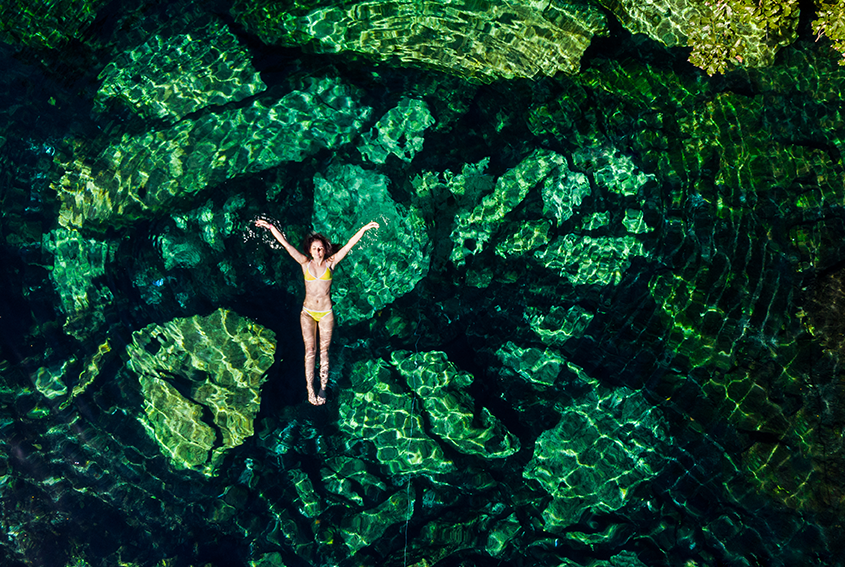
Into the depths of the earth
The Yucatan Peninsula is a vast shelf of porous limestone with no surface rivers. Rainwater seeps through fissures and fault lines in the rock and accumulates in aquifers and underground rivers, which are the only source of fresh water in the area.
The word “cenote” is derived from the Mayan term d’zonot or ts’ono’ot which means “flooded cave,” “abyss” or “depths.” These sinkholes are formed over thousands of years as rainwater reacts with the porous limestone to form carbonic acid, which dissolves, erodes and weakens the rock. Over millions of years, the fissures are enlarged and tunnels and caves are formed. Erosion is twofold, from rainwater on the surface and the underground rivers flowing through the rock. Eventually the rock becomes so unstable that huge slabs carve off and cave roofs collapse, leading to the creation of sinkholes.
Cenotes can be deep lakes or shallow pools and they may suddenly appear as a result of subsidence and a rock fall in a cave. There are several different types of sinkholes: open cenotes are those in which the ancient cave roof has collapsed completely. Partially open cenotes still have a section of the cave roof and there are still others that have a small opening in the roof through which sunlight and the roots of jungle trees filter in.
Native wildlife such as deer, peccary and even the elusive jaguar will gather to drink on the banks of cenotes, swallows and dragonflies dip across the surface and the turquoise-browed motmot bird nests in the limestone walls.
The number of these enigmatic wells scattered through the peninsula is unknown, in the state of Yucatan alone there are between 7,000 and 8,000, many of which are associated with local legends. The Maya believed that cenotes were sacred places – they were the home of the rain god, Chaac, and the gateway to Xibalba, the Underworld. Even today, some communities believe that the aluxes or spirits haunt caves and cenotes and others tell of mythical creatures such as golden crocodiles.
The longest underground rivers discovered in the world to date are in the Tulum area and exploration of this secret world deep in the limestone rock is still underway. Cave divers and archaeologists have made important discoveries about prehistoric creatures such as the sabre tooth tiger and giant sloth, the bands of hunter gatherers who inhabited the area more than 13,000 years ago, and the ancient Maya. They have found bones and traces of very early hunting tools and later offerings of ceramics and other items left in caves by the Maya to honor the gods.
Visiting cenotes is an unforgettable experience. Their cool crystal-clear waters are inviting and quite a surprise after the steamy midday heat and as you swim or snorkel, look down into the depths and marvel at Mother Nature. You’ll see pillars and sculpted columns that look like the turrets and spires of a submerged city and in the distance the black holes of caves and tunnels leading into the unknown.
The Riviera Maya’s hidden wonders
Here’s a guide to some of the Riviera Maya’s cenotes, traveling north to south.
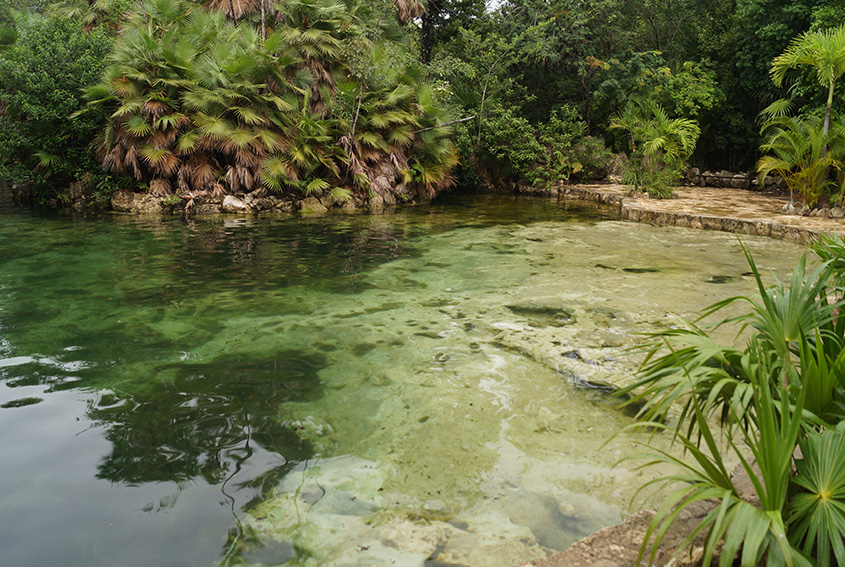
Ruta de los Cenotes
We begin our cenote hopping tour in Puerto Morelos. Just south of this waterfront town, an arch and a sign point you to a road leading west through the forest. This is the Ruta de los Cenotes that leads to a chain of beautiful cenotes and eventually links up with the village of Leona Vicario on Highway 180.
Rustic signs beside the Ruta de los Cenotes road indicate turn offs for jungle trails leading to cenotes open to the public such as Las Mojarras, Kin-Ha, and La Noria where you can zip line, dive in from a tower or just enjoy the view.
The seven mouths that give the Siete Bocas cenote its name glow gently as the sunlight penetrates the turquoise depths. The strange rock formations in this cenote are incredible.
Next stop along the Ruta de los Cenotes is the mysterious underground pool of Boca de Puma. Located in a private jungle reserve, this cenote offers a variety of adventures ranging from snorkeling and zip lining to rock climbing, rappelling down a cliff wall and biking. There is also a chiclero camp where you can learn how the sap of the chicozapote tree was harvested in the area and used to make chewing gum.
Finally, follow a winding trail to Verde Lucero, an open cenote in a forest clearing where another rustic zip line provides hours of fun.
The Xenotes Oasis Maya trip gives you the chance to explore four very different cenotes in one day, trying your hand at snorkeling, zip lining and kayak. The four cenotes are named in Maya after the four elements: K’áak or Fire, Há or Water, Lik’ or Wind and Lu’um or Earth. All are filled with crystal-clear water and strange rock formations, and each has its own charm.
Expert guides point out native flora and fauna as they escort you along jungle trails, explaining how cenotes are formed and their importance as sacred sites for the ancient Maya. They will also tell them about Mayan mythology, including the tale of the Aluxes, the guardian spirits of the forest and the milpa or cornfields.
Xenotes, Oasis Maya is for small groups of visitors and includes the use of snorkeling gear and a life jacket, a gourmet picnic and transport.
For a day of jungle adventures, Selvatica Park also fits the bill. Fly through the jungle canopy on a series of thrilling zip line circuits, then swim in a cenote. ATV jungle tours are also available.
You’ll explore nature trails in these cenote parks and see flocks of parrots and Yucatan jays, toucans and turquoise-browed motmots. The forest is also home to spider monkeys, brocket and white tail deer, peccary, margay, ocelot, puma and the elusive jaguar that park wardens occasionally see at night drinking water from cenotes or in caves.
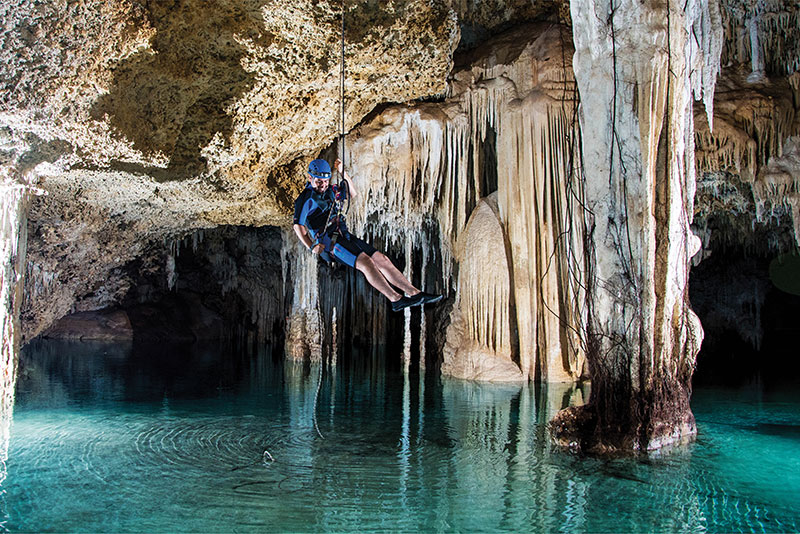
Rio Secreto
Just south of Playa del Carmen, Rio Secreto is another labyrinth of limestone caves and still clear pools that mirror intricate columns, stalactites and stalagmites. Guided tours are available through this hidden treasure.
Cenotes in the Puerto Aventuras Area
A cluster of cenotes lies in the forest to the west of Highway 307 between Puerto Aventuras and Akumal. One mile south of Puerto Aventuras is the Kantun Chi eco-park where two majestic caves and four cenotes (Kantun Chi, Sas Ka Leen Ha, Uchil Ha and Zacil Ha) will surprise even the most intrepid traveler.
In a jungle clearing, Cenote Azul is another large cenote with several inlets for snorkeling. The water is so tempting that you may not be able to resist the urge to take a running jump!
Christened by divers, Taj Mahal is one of the most spectacular in the area; shafts of sunlight like an underwater laser show illuminate endless vistas stretching into the distance. Even more poetically named is Jardín del Edén or Garden of Eden, a large cenote rich in marine life and rimmed by exuberant vegetation that is ideal for an afternoon picnic.
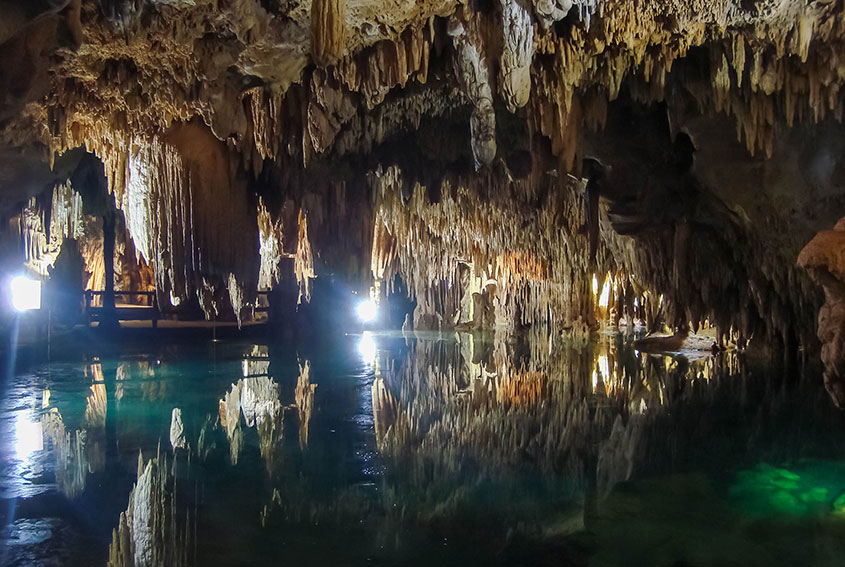
Aktun Chen
In the jungle to the south of Akumal, Aktun Chen is a chain of caves that are illuminated to show the turquoise waters of hidden cenotes and the delicate beauty of the stalactites, stalagmites and flowstones sculpted by water and calcite over millions of years.
After exploring the caves, you can enjoy the park’s other activities such as ip lining, swimming and wildlife watching – spider monkeys, coatimundis and toucans are local inhabitants.
Nohoch Nah Chiich
This incredible cenote is the mouth of the longest underground river system in the world.
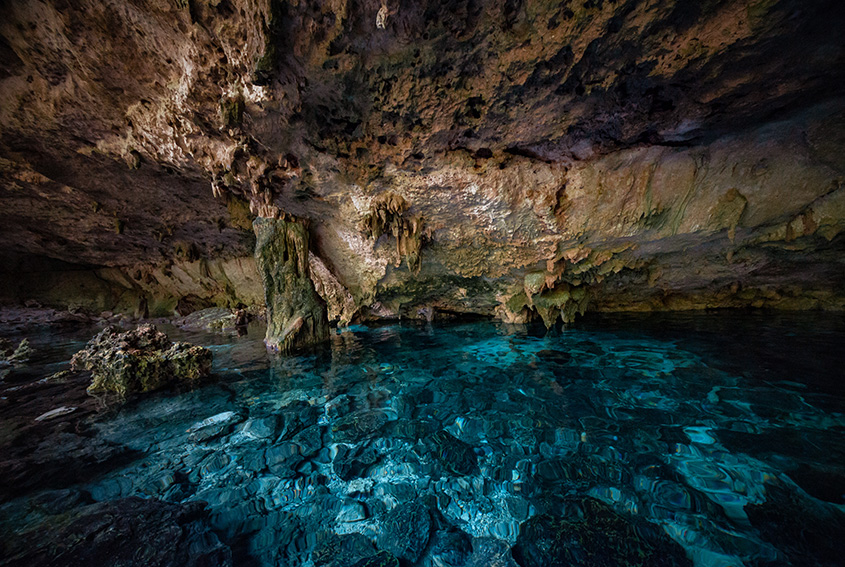
Dos Ojos Cenote Park
A visit to the Dos Ojos Cenote Park in the Tulum area gives you the chance to explore the mysterious underworld of the Yucatan, the intricate labyrinth of caves and underground rivers deep in the limestone rock.
Dos Ojos is the site of two of the longest underground rivers in the world and some of the Riviera Maya’s most beautiful cenotes or sinkholes. With a guide you’ll go snorkeling in several cenotes or sinkholes, try zip lining and enjoy a day in the jungle.
Dos Ojos Park is also the site of the Museum of Prehistory, which casts light on the amazing discoveries of fossils and the bones of the earliest humans to settle the Yucatan Peninsula made by archaeologists and cave divers during explorations of area cenotes.
There are more cenotes to enjoy in the Tulum area and on the way to Coba.
Thomas More Travel can help you book day trips to Rio Secreto, Aktun Chen, Dos Ojos and the many jungle cenote parks in the Riviera Maya. Visit the website or the travel desk in the lobby of your resort.




